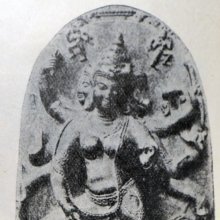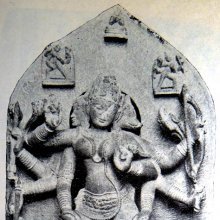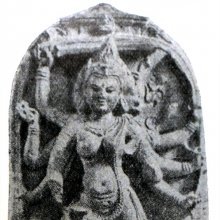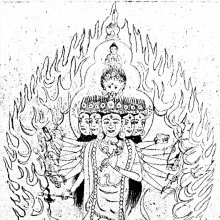Maricipicuva, Mārīcīpicuvā, Marici-picuva: 1 definition
Introduction:
Maricipicuva means something in Buddhism, Pali. If you want to know the exact meaning, history, etymology or English translation of this term then check out the descriptions on this page. Add your comment or reference to a book if you want to contribute to this summary article.
Alternative spellings of this word include Marichipichuva.
Images (photo gallery)
In Buddhism
Tibetan Buddhism (Vajrayana or tantric Buddhism)
Source: archive.org: The Indian Buddhist IconographyMārīcīpicuvā (मारीचीपिचुवा) or Aṣṭabhujapīta-Mārīcī is a variety of Mārīcī: one of the various emanations of Vairocana, as mentioned in the 5th-century Sādhanamālā (a collection of sādhana texts that contain detailed instructions for rituals).—She has three faces and eight arms.
The Dhyāna (meditation instructions) of Aśokakāntā described in the Sādhanamālā as follows:—
“The worshipper should conceive himself as Marlcipicuva who displays the sentiments of Śṛṅgāra, Vīra, and Harṣa in one of her faces, which is of the colour of jāmbunāda (gold). In the middle face which is of the colour of the Indranīla gem, the sentiments of Bhaya, Bībhatsa,and Raudra are displayed; and in the third face of crystal colour, the sentiments of Karuṇā, Adbhuta and Śānta appear. She has three eyes in each one of her three faces, which give freedom from the three great evils. Her essence is made of Dharmakāya and Sambhogakāya. She is clad in garments of yellow colour and resides happily in the mass of rays. She sews up the eyes and the mouths of the wicked with the needle and secures them with the string. She strikes their hearts with the aṅkuśa, draws them by the neck with the noose, pierces them with the bow and the arrow, and shatters their hearts to pieces with the vajra, and then sprinkles water with the leaves of Aśoka... She tramples under her feet prajñā and upāya.”
[Aṣṭabhuja-Mārīcī or Saṃkṣipta-Mārīcī is yellow in colour, wears red garments, is decked in various ornaments, bears the image of Vairocana on the crown and resides within the cavity of a Caitya. Her three faces display three different sentiments. The first, or the principal face displays passionate love, and is of the colour of gold. The second, or the left face is distorted, sow-like, has the colour of the Indranīla gem, displays wrath and looks terrible with bare fangs and protruding lips. The third or the right face is of deep red colour, glows in heavenly splendour and displays the sentiment cf Santa. She rides a chariot drawn by seven pigs, stands in the ālīḍha attitude, and appears a virgin in the fulness of youth. Below the seven sows is the fierce Rāhu, who devours the sun and the moon.
She is surrounded by the four attendant goddesses, Varttālī, Vadālī, Varālī and Varāhamukhī.
(i) Varttālī has red complexion, the sow-face and four arms. She wears red garments, is decked in all sorts of ornaments, and carries the noose and the Aśoka in the two left hands and the Vajrāṅkuśa and the needle in the right.
(ii) Vadālī has many features in common with Varttālī, but her colour is yellow and she carries the noose and the Vajra in the two left hands and Aśoka and the needle in the right.
(iii) Varālī is identical with Vadālī, except that she holds the Vajra and the needle in the two right hands and the noose and the Aśoka in the left.
(iv) Varāhamukhī wears the same garments and the same ornaments as Vadālī and Varālī, but her complexion is ruddy, and she carries the Vajra and the arrow in the two right hands and the Aśoka and the bow in the left.]

Tibetan Buddhism includes schools such as Nyingma, Kadampa, Kagyu and Gelug. Their primary canon of literature is divided in two broad categories: The Kangyur, which consists of Buddha’s words, and the Tengyur, which includes commentaries from various sources. Esotericism and tantra techniques (vajrayāna) are collected indepently.
See also (Relevant definitions)
Partial matches: Picuva, Marici.
Full-text: Varali, Ashtabhujapita, Samkshiptamarici, Ashtabhujamarici, Vadali, Varahamukhi, Varttali, Marici.
Relevant text
Search found 1 books and stories containing Maricipicuva, Mārīcīpicuvā, Marici-picuva, Mārīcī-picuvā; (plurals include: Maricipicuvas, Mārīcīpicuvās, picuvas, picuvās). You can also click to the full overview containing English textual excerpts. Below are direct links for the most relevant articles:
The Indian Buddhist Iconography (by Benoytosh Bhattachacharyya)



